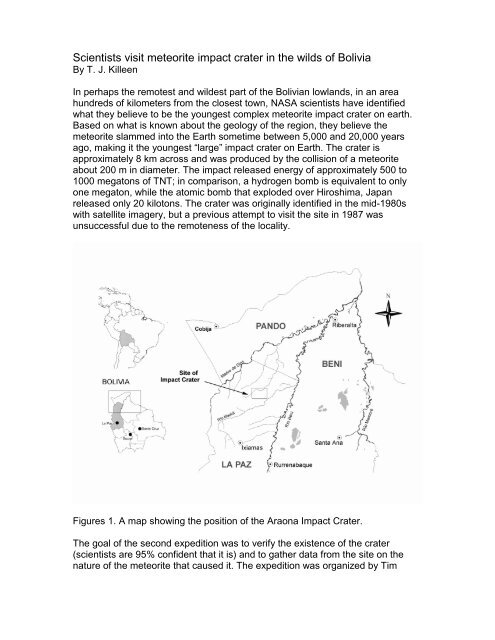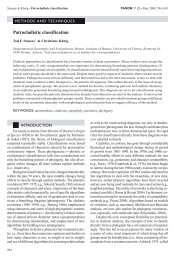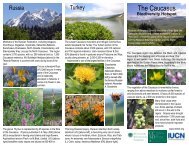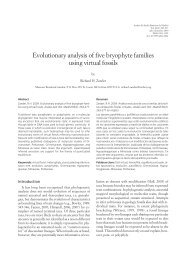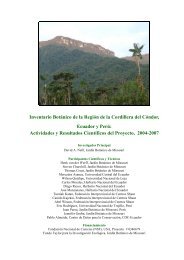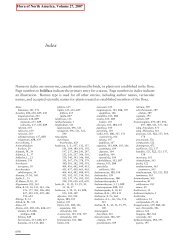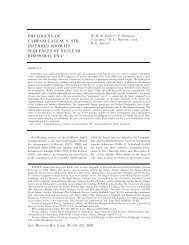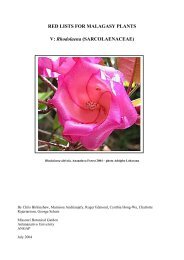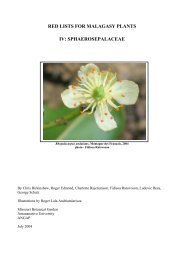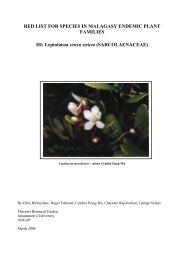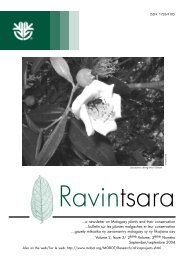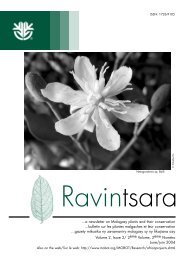Scientists visit meteorite impact crater in the wilds of Bolivia
Scientists visit meteorite impact crater in the wilds of Bolivia
Scientists visit meteorite impact crater in the wilds of Bolivia
You also want an ePaper? Increase the reach of your titles
YUMPU automatically turns print PDFs into web optimized ePapers that Google loves.
<strong>Scientists</strong> <strong>visit</strong> <strong>meteorite</strong> <strong>impact</strong> <strong>crater</strong> <strong>in</strong> <strong>the</strong> <strong>wilds</strong> <strong>of</strong> <strong>Bolivia</strong><br />
By T. J. Killeen<br />
In perhaps <strong>the</strong> remotest and wildest part <strong>of</strong> <strong>the</strong> <strong>Bolivia</strong>n lowlands, <strong>in</strong> an area<br />
hundreds <strong>of</strong> kilometers from <strong>the</strong> closest town, NASA scientists have identified<br />
what <strong>the</strong>y believe to be <strong>the</strong> youngest complex <strong>meteorite</strong> <strong>impact</strong> <strong>crater</strong> on earth.<br />
Based on what is known about <strong>the</strong> geology <strong>of</strong> <strong>the</strong> region, <strong>the</strong>y believe <strong>the</strong><br />
<strong>meteorite</strong> slammed <strong>in</strong>to <strong>the</strong> Earth sometime between 5,000 and 20,000 years<br />
ago, mak<strong>in</strong>g it <strong>the</strong> youngest “large” <strong>impact</strong> <strong>crater</strong> on Earth. The <strong>crater</strong> is<br />
approximately 8 km across and was produced by <strong>the</strong> collision <strong>of</strong> a <strong>meteorite</strong><br />
about 200 m <strong>in</strong> diameter. The <strong>impact</strong> released energy <strong>of</strong> approximately 500 to<br />
1000 megatons <strong>of</strong> TNT; <strong>in</strong> comparison, a hydrogen bomb is equivalent to only<br />
one megaton, while <strong>the</strong> atomic bomb that exploded over Hiroshima, Japan<br />
released only 20 kilotons. The <strong>crater</strong> was orig<strong>in</strong>ally identified <strong>in</strong> <strong>the</strong> mid-1980s<br />
with satellite imagery, but a previous attempt to <strong>visit</strong> <strong>the</strong> site <strong>in</strong> 1987 was<br />
unsuccessful due to <strong>the</strong> remoteness <strong>of</strong> <strong>the</strong> locality.<br />
Figures 1. A map show<strong>in</strong>g <strong>the</strong> position <strong>of</strong> <strong>the</strong> Araona Impact Crater.<br />
The goal <strong>of</strong> <strong>the</strong> second expedition was to verify <strong>the</strong> existence <strong>of</strong> <strong>the</strong> <strong>crater</strong><br />
(scientists are 95% confident that it is) and to ga<strong>the</strong>r data from <strong>the</strong> site on <strong>the</strong><br />
nature <strong>of</strong> <strong>the</strong> <strong>meteorite</strong> that caused it. The expedition was organized by Tim
Killeen, formerly with <strong>the</strong> Missouri Botanical Garden, and Compton Tucker, a<br />
specialist <strong>in</strong> remote sens<strong>in</strong>g technology with NASA’s Goddard Space Flight<br />
Center. Both Tucker and Killeen have been work<strong>in</strong>g <strong>in</strong> <strong>Bolivia</strong> for <strong>the</strong> past several<br />
years mapp<strong>in</strong>g vegetation types, as part <strong>of</strong> an effort to understand <strong>the</strong> processes<br />
that lead to <strong>the</strong> development <strong>of</strong> different habitats. Accompany<strong>in</strong>g <strong>the</strong>m was Peter<br />
Wazelewski, a specialist <strong>in</strong> <strong>meteorite</strong> <strong>impact</strong> <strong>crater</strong>s, who was <strong>in</strong>terested <strong>in</strong><br />
<strong>visit</strong><strong>in</strong>g <strong>the</strong> only (potential) <strong>crater</strong> known to exist <strong>in</strong> alluvial sediments. All o<strong>the</strong>r<br />
<strong>crater</strong>s are found <strong>in</strong> hard rock formations, s<strong>in</strong>ce <strong>crater</strong>s formed by meteroite<br />
<strong>impact</strong>s <strong>in</strong> unconsolidated sediments are erased quickly by erosion and<br />
sedimentation.<br />
Figure 2. A false-color composite <strong>of</strong> a Landsat TM satellite image show<strong>in</strong>g <strong>the</strong><br />
<strong>impact</strong> <strong>crater</strong> (red colors are forest vegetation, blues are savanna grasslands).<br />
Soil samples (open circles) were taken along a trail (irregular l<strong>in</strong>e <strong>in</strong> <strong>the</strong> upper<br />
right hand quadrant), between “old growth” Amazonian forest dom<strong>in</strong>ated by<br />
Bertholetia exclesior (Brazil nut), across transitional forest types dom<strong>in</strong>ated by<br />
Phenakospermum guianensis (Patujú), and extend<strong>in</strong>g <strong>in</strong>to <strong>the</strong> savanna<br />
vegetation <strong>in</strong> <strong>the</strong> center <strong>of</strong> <strong>the</strong> <strong>crater</strong>. A proxy soil pit <strong>in</strong> open treeless grassland<br />
was taken at <strong>the</strong> end <strong>of</strong> <strong>the</strong> airstrip at <strong>the</strong> Araona village (lower left quadrant.<br />
The expedition reached <strong>the</strong> <strong>crater</strong> <strong>impact</strong> site after travel<strong>in</strong>g by jet airl<strong>in</strong>er, small<br />
airplane, motor boat, dugout canoe, and f<strong>in</strong>ally by cutt<strong>in</strong>g a 15 km long trail<br />
through <strong>the</strong> forest. Field data ga<strong>the</strong>red dur<strong>in</strong>g <strong>the</strong> expedition supports <strong>the</strong><br />
hypo<strong>the</strong>sis that <strong>the</strong> circular feature is a <strong>meteorite</strong> <strong>impact</strong> <strong>crater</strong>. The r<strong>in</strong>gs visible
on <strong>the</strong> satellite image correspond to slight ridges not more than 2 m <strong>in</strong> elevation,<br />
but sufficiently higher to support upland forest vegetation, while <strong>the</strong> <strong>in</strong>terior <strong>of</strong> <strong>the</strong><br />
<strong>crater</strong> is ei<strong>the</strong>r <strong>in</strong>undated savanna or flooded forest. However, only sophisticated<br />
methods us<strong>in</strong>g seismology and magnetometry can def<strong>in</strong>itively prove <strong>the</strong><br />
existence <strong>of</strong> a <strong>meteorite</strong> or <strong>meteorite</strong> fragments buried beneath hundreds <strong>of</strong><br />
meters <strong>of</strong> alluvial deposits.<br />
NASA scientists were accompanied by biologists from <strong>the</strong> Missouri Botanical<br />
Garden, The Field Museum <strong>of</strong> Natural History, and <strong>the</strong> Noel Kempff Mercado<br />
Natural History Museum <strong>in</strong> Santa Cruz, <strong>Bolivia</strong>. The area is especially <strong>in</strong>terest<strong>in</strong>g<br />
to <strong>the</strong>m because it is <strong>in</strong> a region unspoiled by modern man and has never been<br />
<strong>visit</strong>ed by biologists. The only community with<strong>in</strong> a 200 km radius <strong>of</strong> <strong>the</strong> <strong>crater</strong> is a<br />
small village <strong>of</strong> about 40 people <strong>of</strong> <strong>the</strong> Araona <strong>in</strong>digenous group, which is<br />
situated just 30 km upstream on <strong>the</strong> Río Manupari (see Figure 1 and 2). The<br />
biological specimens collected have been <strong>in</strong>corporated <strong>in</strong>to <strong>the</strong> grow<strong>in</strong>g<br />
collections from nor<strong>the</strong>rn <strong>Bolivia</strong> (see table 1 for list <strong>of</strong> bird species collected or<br />
observed).<br />
Table 1. List Bird species observed or<br />
collected <strong>the</strong> Rio Manupare Region<br />
Taxa Habitat<br />
TINAMIFORMES, TINAMIDAE<br />
T<strong>in</strong>amus major ft<br />
T<strong>in</strong>amus tao fh<br />
Crypturellus c<strong>in</strong>ereus ft,fh<br />
Crypturellus parvirostris cd,cf,cp<br />
Crypturellus soui fh,ft,fe<br />
Crypturellus undulatus<br />
Crypturellus undulatus fh,ft<br />
CICONIIFORMES, ARDEIDAE<br />
Tigrisoma l<strong>in</strong>eatum ri,rm,sm<br />
Nycticorax pileatus rm<br />
Ardeola ibis rm,cf<br />
Ardeola ibis rm,cf<br />
Butorides striatus rm, ma<br />
Egretta alba rm, ma<br />
Ardea cocoi rm,sm<br />
CICONIIFORMES, THRESKIORNITHIDAE<br />
Mesembr<strong>in</strong>ibis cayennensis cf,rm,ma<br />
ANSERIFORMES, ANATIDAE<br />
Cair<strong>in</strong>a moschata rm,ma<br />
FALCONIFORMES, CATHARTIDAE<br />
Cathartes aura u<br />
Cathartes melambrotus fh<br />
Coragyps atratus fh,ft,fd,cd,sg<br />
Sarcoramphus papa fh<br />
FALCONIFORMES, ACCIPITRIDAE<br />
Elanoides forficatus fh,ft,fd<br />
Ict<strong>in</strong>ia plumbea fh,fd,fe<br />
Geranospiza caerulescens ft<br />
Leucopternis kuhli fh<br />
Buteo magnirostris u<br />
Spizaetus ornatus<br />
FALCONIFORMES, FALCONIDAE<br />
fh<br />
Herpeto<strong>the</strong>res cach<strong>in</strong>nans fe,cf,cp<br />
Micrastur ruficollis fh,fi<br />
Falco rufigularis<br />
GALLINIFORMES,<br />
CRACIDAE<br />
fh.fe<br />
Penelope jacquacu fh,ft<br />
Aburria pipile fh<br />
Crax (mitu) tuberosa<br />
GALLINIFORMES, PHASIANIDAE<br />
fh<br />
Odontophorus stellatus<br />
GRUIFORMES, RALLIDAE<br />
fh<br />
Aramides cajanea<br />
GRUIFORMES, HELIORNITHIDAE<br />
ft,rm<br />
Heliornis fulica<br />
GRUIFORMES, EURYPYGIDAE<br />
rm,ma<br />
Eurypyga helias rm,sm<br />
CHARADRIIFORMES, CHARADRIIDAE<br />
Vanellus chilensis cf,rm<br />
CHARADRIIFORMES, SCOLOPACIDAE<br />
Bartramia longicauda fe,cd,cp<br />
Tr<strong>in</strong>ga solitaria cf,rm<br />
Actitis macularia rm<br />
CHARADRIIFORMES, COLUMBIDAE<br />
Columba cayennensis fg,fe,cf,cp<br />
Columba plumbea fh<br />
Columba subv<strong>in</strong>acea fh,ft<br />
Columb<strong>in</strong>a picui fe,sg<br />
Columb<strong>in</strong>a talpacoti fe,cp,sg<br />
Leptotila rufaxilla fh,ft,fd,fe<br />
Geotrygon montana fh,ft
PSITTACIFORMES, PSITTACIDAE<br />
Ara ararauna fh,ft,fd,fg<br />
Ara chloroptera fh<br />
Ara macao fh.ft<br />
Ara manilata ft<br />
Ara severa fh,ft<br />
Ara nobilis fg<br />
Arat<strong>in</strong>ga aurea fg,cd<br />
Arat<strong>in</strong>ga leucophthalmus ft,fg<br />
Pyrrhura picta ft<br />
Brotogeris cyanoptera ft<br />
Pionites leucogaster fh<br />
Pionopsitta barrabandi fh<br />
Pionus menstruus fh<br />
Amazona ochrocephala<br />
CUCULIFORMES,<br />
CUCULIDAE<br />
ft<br />
Piaya cayana fh,ft<br />
Piaya m<strong>in</strong>uta fe<br />
Crotophaga ani fe,cf,ma,rm,s<br />
g<br />
Crotophaga major<br />
STRINGIFORMES,<br />
STRIGIDAE<br />
ma,rm,sm<br />
Otus watsonii fh,ft<br />
Lophostrix cristata fh<br />
Pulsatrix perspicillata fh<br />
CAPRIMURGIFORMES, NYCTIBIDAE<br />
Nyctibius ae<strong>the</strong>reus fh<br />
Nyctibius grandis fh,fd<br />
CAPRIMURGIFORMES, CAPRIMULGIDAE<br />
Podager nacunda cp,ri<br />
Nyctidromus albicolus fg,fe<br />
Nyctiphrynus ocellatus fh<br />
Caprimulgus rufus fe,fh<br />
Caprimulgus<br />
fe<br />
sericocaudatus<br />
APODIFORMES, APODIDADEA<br />
Chaetura brachyura u<br />
Chaetura c<strong>in</strong>ereiventris u<br />
Chaetura egregia u<br />
Tachornis squamata cf<br />
APODIFORMES, TROCHILIDAE<br />
Phaethornis supercilliosus fh,ft<br />
Phaethornis ruber fe<br />
Thalurania furcata fh,ft<br />
Hylocharis cyanus ft<br />
TROGONIFORMES, TROGONIDAE<br />
Trogon melanurus fh,ft<br />
Trogon viridis fh,ft<br />
CORACIIFORMES, ALCEDINIDAE<br />
Ceryle torquata rm<br />
Chloroceryle aena rm,sm<br />
Chloroceryle amazona rm<br />
Chloroceryle americana rm,ma<br />
Chloroceryle <strong>in</strong>da rm,sm<br />
CORACIIFORMES, MOMOTIDAE<br />
Momotus momota<br />
PICIFORMES, GALBULIDAE<br />
fh,ft<br />
Galbula cyanescens fh,fd<br />
Galbula dea<br />
PICIFORMES, BUCCONIDAE<br />
fh<br />
Melacoptila semic<strong>in</strong>cta fh<br />
Monasa morphoeus fh<br />
Monasca nigrifrons ft<br />
Chelidoptera tenebrosa fe,rm<br />
Notharchus macrorhynchos<br />
PICIFORMES, CAPITONIDAE<br />
fh<br />
Capito niger<br />
PICIFORMES, RAMPHASTIDAE<br />
fh<br />
Pteroglossus<br />
fh<br />
beauharnaesii<br />
Pteroglossus flavirostris fh,ft<br />
Pteroglossus <strong>in</strong>scriptus fh<br />
Selenidera re<strong>in</strong>wardtii fh<br />
Ramphastos tucanus fh,ft<br />
Ramphastos vitell<strong>in</strong>us<br />
PICIFORMES, PICIDAE<br />
fh,ft<br />
Melanerpes cruentatus fe<br />
Piculus chrysochloros fh,ft<br />
Celeus elegans ft,fh<br />
Celeus grammicus ft<br />
Campephilus rubicollis fh,ft<br />
PASSERIFORMES, DENDROCOLAPTIDAE<br />
Dendroc<strong>in</strong>cla fulig<strong>in</strong>osa fh,ft<br />
Dendroc<strong>in</strong>cla merula fh<br />
Sittasomus griseicapillus cd,fg,fd<br />
Glyphorynchus spirurus fh,ft<br />
Dendrexetastes rufigula fh<br />
Xiphocolaptes<br />
fh<br />
promeropirhynchus<br />
Xiphorhynchus guttatus fh,ft,fd<br />
Xiphorhynchus spixii fh<br />
PASSERIFORMES, FURNARIIDAE<br />
Synallaxis rutilans fh,ft<br />
Ancistrops strigilatus<br />
Automolus ochrolaemus fh,ft<br />
Xenops m<strong>in</strong>utus fh,ft<br />
Xenops milleri fh,ft<br />
PASSERIFORMES, FORMICARIIDAE<br />
Cymbilaimus l<strong>in</strong>eatus fh<br />
Taraba major fd,ft,fe<br />
Thamnophilus aethiops fh<br />
Thamnophilus amazonicus fh<br />
Thamnophilus schistaceus fh<br />
Myrmo<strong>the</strong>rula longipennis ft<br />
Myrmo<strong>the</strong>rula axillaris fh,ft<br />
Myrmo<strong>the</strong>rula brachyura fh<br />
Myrmo<strong>the</strong>rula mentriesii fh,ft<br />
Myrmo<strong>the</strong>rula sclateri ft<br />
Cercomacra c<strong>in</strong>erascens fh,ft<br />
Myrmoborus myo<strong>the</strong>r<strong>in</strong>us
Myrmoborus leucophrys ft<br />
Hypocnemis cantator fh,ft<br />
Hypocnemoides<br />
maculicauda<br />
ft<br />
Sclateria naevia ft,sm<br />
Myrmeciza hemimelaena fh,ft<br />
Hylophylax poecil<strong>in</strong>ota fh,ft<br />
Gymnopithys salv<strong>in</strong>i<br />
Dichrozona c<strong>in</strong>cta<br />
fh<br />
Formicarius colma<br />
PASSERIFORMES, TYRAMNIDAE<br />
fh<br />
Myiopagis gaimardii fh,ft<br />
Myiopagis viridicata fh,ft<br />
Mionectes oleag<strong>in</strong>eus fh,ft<br />
Leptopogon<br />
amaurocephalus<br />
fh,ft<br />
Myiornis ecaudatus fe<br />
Hemitriccus zosterops fh,ft<br />
Hemitriccus iohannis? cd,cp<br />
Ramphotrigon ruficauda fh,ft<br />
Tolmomyias poliocephalus fh<br />
Onychorhynchus coronatus fh<br />
Pyrocephalus rub<strong>in</strong>us fe,cp<br />
Ochthoeaca littoralis rm.ma<br />
Attila bolivianus ft<br />
Attila spadiceus fh,ft<br />
Rhytipterna simplex fh,ft<br />
Laniocera hypopyrra fh,ft<br />
Myiarchus tyrannulus fh,ft,fe<br />
Myiodynastes (maculatus)<br />
solitarius<br />
fh,ft,fg<br />
Empidonomus<br />
aurantioatrocristatus<br />
fh,ft,fg<br />
Empidonomus varius fh,ft,fg<br />
Tyrannus melancholicus u<br />
Tyrannus savana<br />
Tyrannus tyrannus<br />
rm,cp,cd<br />
Pachyramphus m<strong>in</strong>or fh<br />
Tityra semifasciata<br />
'PASSERIFORMES,<br />
PIPRIDAE<br />
fh,ft,fg<br />
Schiffornis major ft<br />
Schiffornis turdidus fh,ft<br />
Piprites chloris fh<br />
Tyranneutes stolzmanni fh<br />
Heterocercus l<strong>in</strong>teatus ft<br />
Machaeropterus<br />
pyrocephalus<br />
fh,ft<br />
Pipra fasciicauda fh,ft<br />
Pipra rubocapilla<br />
PASSERIFORMES, COTINGIDAE<br />
fh,ft<br />
Lipaugus vociferans fh,ft<br />
Querula purpurata ft<br />
Gymnoderus foetidus fh,ft<br />
Iodopleura isabellae<br />
PASSERIFORMES, HIRUNDINIDAE<br />
Progne chalybea u<br />
Progne tapera u<br />
Atticora fasciata ri,rm<br />
Stelgidopteryx ruficollis ri,rm,cp<br />
Riparia riparia ri,rm,cp<br />
PASSERIFORMES, TROGLODYTIDAE<br />
Thryothorus genibarbis fh,ft<br />
Troglodytes aedon fe,sg,bg<br />
Microcerculus marg<strong>in</strong>atus fh<br />
PASSERIFORMES, EMBERIZIDAE,<br />
EMBERIZINAE<br />
Ammodramus humeralis cp<br />
PASSERIFORMES, EMBERIZIDAE,<br />
CARDINALINAE<br />
Saltator maximus fe,fh,ft<br />
PASSERIFORMES, EMBERIZIDAE,<br />
THRAUPINAE<br />
Hemithraupis flavicollis fh,ft<br />
Tachyphonus cristatus fh<br />
Habia rubica fh,ft,fd<br />
Ramphocelus carbo fe,sg<br />
Thraupis palmarum fe,sg<br />
Thraupis sayaca fe,sg,ft<br />
Euphonia chlorotica cp,cd,fe<br />
Tangara velia fh,ft<br />
Tangara mexicana fh,ft<br />
Dacnis cayana fh,ft<br />
Ters<strong>in</strong>a viridis fe,rm<br />
PASSERIFORMES, EMBERIZIDAE,<br />
PARULINAE<br />
Phaeothlypis fulvicauda fh,sm<br />
PASSERIFORMES, VIREONIDAE<br />
Vireo (olivaceus) chivi bt bi<br />
Hylophilus hypoxantha bt<br />
Hylophilus semic<strong>in</strong>ereus bt bm<br />
PASSERIFORMES, ICTERIDAE<br />
Psarocolius bifasciatus bi bt<br />
Psarocolius angustifros bt bt<br />
Cacicus cela bi bm<br />
Scaphidura oryzivora bi bp ma<br />
ft =terra firme<br />
fh =lower stature forest<br />
ft, fh (order altered if species more prevelant <strong>in</strong><br />
one or <strong>the</strong> o<strong>the</strong>r.)<br />
cd, cf, cp = cerrado, seasonally flooded grassland,<br />
campo<br />
fe = forest edge<br />
ri, rm, sm river, river marg<strong>in</strong>, stream marg<strong>in</strong><br />
ma = marsh<br />
The expedition also allowed Killeen, Tucker and a <strong>Bolivia</strong>n student, Teddy Siles,<br />
to study <strong>the</strong> past ecological history <strong>of</strong> <strong>the</strong> region. The <strong>crater</strong> is situated on <strong>the</strong>
<strong>in</strong>terface <strong>of</strong> <strong>the</strong> Amazon forest and <strong>the</strong> vast open savannas <strong>of</strong> eastern <strong>Bolivia</strong>. A<br />
prelim<strong>in</strong>ary evaluation <strong>of</strong> <strong>the</strong> images identified patches <strong>of</strong> low forest north <strong>of</strong> <strong>the</strong><br />
dC 13 Value<br />
-10.00<br />
-15.00<br />
-20.00<br />
-25.00<br />
-30.00<br />
Araona Crater - Ecotone Transect<br />
Stable Carbon Isotope Ratios from Soil Pr<strong>of</strong>iles<br />
0-1 1-6 10-15<br />
Soil Depth (cm)<br />
35-50 80-100<br />
M-7 Open Grassland<br />
M-6 Savanna Scrub<br />
M-5 Inundated<br />
Transitional Forest<br />
.<br />
M-4 Early Secondary<br />
Forest<br />
M-3 Late Secondary<br />
Forest<br />
M-2 High Forest<br />
Figure 3. Diagram <strong>of</strong> soil pr<strong>of</strong>iles established a long a savanna – forest ecotone<br />
near <strong>the</strong> Araona Impact Crater on <strong>the</strong> Manupari River (La Paz, <strong>Bolivia</strong>).<br />
current savanna – forest edge, lead<strong>in</strong>g <strong>the</strong>m to hypo<strong>the</strong>size that <strong>the</strong> forest –<br />
forest ecotone has migrated South <strong>in</strong> recent history. The expedition provided<br />
<strong>the</strong>m with a unique opportunity to test this hypo<strong>the</strong>sis us<strong>in</strong>g soil samples<br />
collected along a transect across <strong>the</strong> savanna forest ecotone.<br />
Table 2. Summary <strong>of</strong> <strong>the</strong> vegetation structure at seven soil sample sites<br />
established on <strong>the</strong> ecotone transect.<br />
Woody Cover Density Mean Height Basal Area<br />
M-1 High Forest > 100 % 48 23 3.15<br />
M-2 High Forest > 100 % 52 25 4.39<br />
M-3 Late Secondary Forest > 100 % 53 22 1.98<br />
M-4 Early Secondary Forest > 100 % 53 19 2.31<br />
M-5 Inundated Transitional Forest > 100 % 64 8 1.43<br />
M-6 Savanna Scrub 25 - 30 % 2 2 0.06<br />
M-7 Open Grassland 0 - 5 % 0 - -<br />
Soil organic matter (SOM) provides a record <strong>of</strong> <strong>the</strong> vegetation that occupied a<br />
site <strong>in</strong> <strong>the</strong> past. The grass species <strong>in</strong> <strong>the</strong> savanna at Noel Kempff Park use <strong>the</strong><br />
C4 metabolic pathway and <strong>the</strong>refore conta<strong>in</strong>s an elevated amount <strong>of</strong> <strong>the</strong> stable
carbon isotope 13 C when compared to <strong>the</strong> forest plants. The relative amount <strong>of</strong><br />
13 C is quantified as <strong>the</strong> ratio <strong>of</strong> 13 C to 12 C and expressed as a per mil deviation<br />
from a geological standard (dC 13 ). Savanna grass tissue has a dC 13 value <strong>of</strong><br />
approximately -12, while forest plants range from -25 to -30. Over time, <strong>the</strong> SOM<br />
at a site will mirror <strong>the</strong> stable carbon isotope value <strong>of</strong> <strong>the</strong> vegetation grow<strong>in</strong>g on<br />
it. For example, SOM <strong>in</strong> an area, which has been covered with tropical savanna<br />
grassland will have a dC 13 value approach<strong>in</strong>g that <strong>of</strong> <strong>the</strong> live savanna grass<br />
tissue. In <strong>the</strong> event <strong>of</strong> a change <strong>in</strong> vegetation, <strong>the</strong> SOM will serve as an <strong>in</strong>dicator<br />
<strong>of</strong> past vegetation at <strong>the</strong> site. If SOM with a dC 13 value <strong>of</strong> between -20 and -25<br />
were found under savanna vegetation, it would <strong>in</strong>dicate that <strong>the</strong> area was<br />
previously occupied by forest vegetation.<br />
Prelim<strong>in</strong>ary evidence from <strong>the</strong> soils samples taken <strong>in</strong>dicates that <strong>the</strong> Amazon<br />
forest has expanded southward <strong>in</strong> recent geological time, an <strong>in</strong>dication <strong>of</strong> past<br />
climate change (Figure 3). Even <strong>the</strong> most nor<strong>the</strong>rn soil pits (M-1, M-2 and M-3)<br />
taken some 20 km North <strong>of</strong> <strong>the</strong> current boundary showed some evidence <strong>of</strong> C4<br />
grasses <strong>in</strong> <strong>the</strong> lowest (and oldest) part <strong>of</strong> <strong>the</strong> soil pr<strong>of</strong>ile, while <strong>the</strong> proxy sample<br />
taken <strong>in</strong> open grassland south <strong>of</strong> <strong>the</strong> airstrip near <strong>the</strong> Araona Village (M-7)<br />
showed no evidence <strong>of</strong> recent forest cover. The transitional sites all show<br />
evidence <strong>of</strong> past movement <strong>in</strong> <strong>the</strong> forest – savanna ecotone. The two sites that<br />
are currently forested (M-4 and M-5) had dC13 values <strong>in</strong> <strong>the</strong> upper horizon<br />
typical <strong>of</strong> forest vegetation, while deeper soil pr<strong>of</strong>iles were more like those found<br />
<strong>in</strong> <strong>the</strong> savanna soils (M-7). Similarly, <strong>the</strong> savanna patch found <strong>in</strong> <strong>the</strong> center <strong>of</strong> <strong>the</strong><br />
<strong>crater</strong> had top soil characteristics <strong>in</strong>termediate to open grassland and closed<br />
forest, reflect<strong>in</strong>g <strong>the</strong> its grass sward and <strong>the</strong> presence <strong>of</strong> a numerous shrubs and<br />
herbaceous forbs (Table 2).


